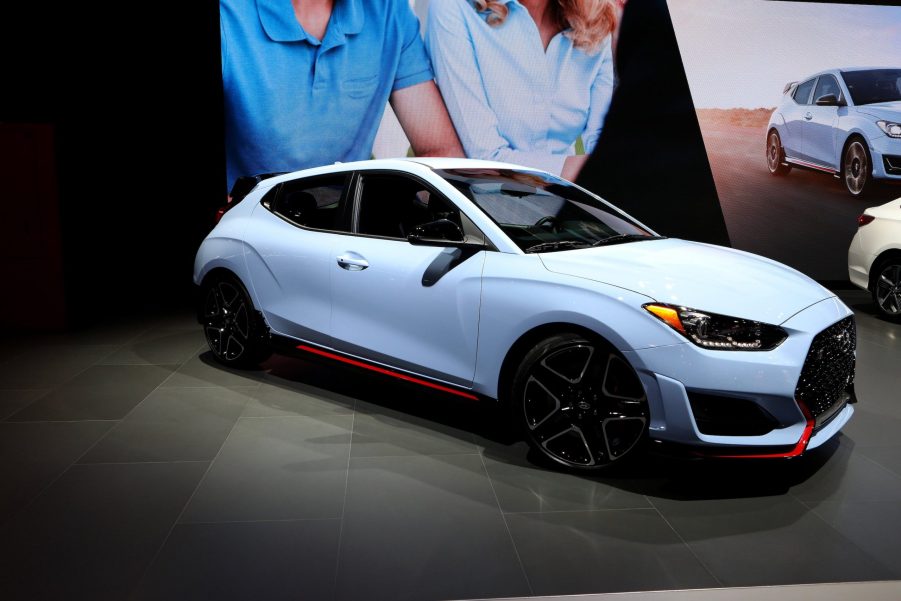
Don’t Let the 2021 Hyundai Veloster’s Quirk Stop You From Buying This Safe Car
The Hyundai Veloster is one of the liveliest members of the automaker’s lineup, but it has one odd quality. Fortunately, it doesn’t affect the car’s performance, nor does it negatively impact the interior capacity. Still, some drivers might be perplexed and worried because the Veloster only has three doors.
It’s a strange design choice, but it doesn’t make the Hyundai Veloster any less safe than its rivals. In fact, U.S. News says this compact car is one of the safest models on the market. When you look at all the Hyundai Veloster’s other good qualities, one less door is hardly a dealbreaker.
Why you shouldn’t skip the Hyundai Veloster
Safety features like lane-keeping assistance, forward-collision warning, driver attention monitoring, and automatic emergency braking are standard for around $18,900. Turbo R-Spec trims come with blind-spot monitors and LED headlights. The top-tier Veloster Turbo Ultimate gains a head-up display, rain-sensing wipers, and pedestrian detection for the forward-collision warning system.
The 2021 Hyundai Veloster received mostly good ratings on all of its crash tests from the IIHS. It performed above-average for front crash prevention but got a “Poor” ranking for its headlights. Drivers concerned about this might feel safer opting for the LED headlights, standard on the Turbo R-Spec trim and above.
The Hyundai Veloster’s base powertrain is a 147-hp 2.5-liter four-cylinder engine paired with a manual or automatic six-speed transmission. Most critics recommend getting a model with the 201-hp turbo-four for better acceleration but sticking with the manual transmission. The Veloster Turbo models come with a dual-clutch seven-speed automatic, but some critics say it’s not that engaging.
None of the Veloster models are excellent on gas, but all of them are fun to handle. While the suspension is on the firm side, the majority of critics were still impressed with the smooth ride quality. The cabin is also very quiet compared to other cars in the Veloster’s class.
You can see how Hyundai managed to get away with the Veloster’s low price point by peeking inside the cabin. Hard plastic reigns supreme, though the interior itself still looks pleasing to the eye. The color scheme is unique and every panel fits properly into its place.
The Hyundai Veloster can house four riders on either cloth or leather seats. Critics say that both options are comfortable, but the leather ones offer less adjustability. The front row is predictably more spacious, but the back row can still fit adults in a pinch.
The standard infotainment is easy to use, equipped with smartphone integration and Bluetooth. Wireless charging, a bigger touchscreen, navigation, and an upgraded speaker system can be found in higher trims.
Want more power? Get the Veloster N
The sportier Hyundai Veloster N comes equipped with a turbo-four producing 275 hp and 260 lb-ft of torque. The six-speed manual transmission is standard, though drivers can also get an eight-speed dual-clutch automatic complete with paddle shifters.
This model also has bigger brake rotors, a sport-tuned suspension, and an electronic limited-slip differential. You can easily differentiate it from a normal Veloster thanks to its giant exhaust and stylish rear spoiler.
But why three doors?
Hyundai hasn’t given an official reason why the Veloster is missing a door, leaving us to speculate. The News Wheel guesses that it might be to add some much-needed convenience for passengers. Small cars don’t always have the easiest seat access, but a long passenger door can help alleviate this problem.
Hyundai has also stated that, without a street-facing passenger door, riders are less likely to be injured by passing cars. Combined with the Veloster’s many driver’s aids and top-notch crash-test scores, it’s an obvious choice for safety-minded shoppers.



